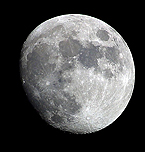Researchers Find No Water In Moon’s Mantle
August 6, 2010

Recently, there’s been a fair amount of interest and excitement about whether or not there is actually water on the moon. And it’s true, water has been detected on the moon’s surface through remote sensing. However, researchers at the University of New Mexico, UCLA, University of Texas at Austin and Los Alamos National Laboratory, have taken a deeper look within the Moon’s mantle and the results tell a different story. Their findings were published this week in a Sciencexpress Report titled, “The Chlorine Isotope Composition of the Moon and Implications for an Anhydrous Mantle.”
“The water we’re hearing about comes from comets that have slammed into the Moon,” said UNM Earth and Planetary Sciences and Regents Professor Zachary Sharp. “It’s cometary ice and it’s great for man-space exploration but it’s unrelated to water in the Moon’s mantle.”
For the last 35 years, the prevalent thinking was that there were no signs of any hydrogen on the Moon. Comets are thought to consist chiefly of ammonia, methane, carbon dioxide and water, which helps to explain the recent findings of water on the Moon.
After conducting research on primitive mantle basalts on Earth, Sharp decided to take a look at the Moon. Sharp and his colleagues, including Research Professor Chip Shearer from UNM’s Institute of Meteoritics, used a gas source mass spectrometer to measure chlorine isotopic composition of lunar basalts and volcanic glass beads collected during the Apollo missions and given to UNM by Johnson Space Center.
“No one had ever looked at chlorine isotope values of the Moon before,” Sharp said. “Our technique was completely independent. Our system used a gas source mass spectrometer which we have in my lab,” said Sharp. “We’re the only lab in the world that has the capabilities to make these measurements using small amounts of lunar material.”
A wide range of sample types were chosen to allow the researchers to assess the effects of chemical composition/mineralogy and surface processing.
“Looking at tiny glass beads we measured the chlorine isotope data from lunar basalts and volcanic glasses to assess the water content of the Moon.”
Apatite grains were also analyzed at UCLA’s Department of Earth and Earth Sciences under the direction of K.D. McKeegan, while a thin film of NaCl (sodium chloride) was irradiated with a 100 kiloelectron volt proton beam at the Ion Beam Materials Laboratory at LANL to assess the potential effect of solar wind on the chlorine isotope ratio of the lunar regolith and soils. Led by LANL’s Y.Q. Wang, the irradiated sample was analyzed for its chlorine isotope composition.
The researchers were expecting to find a very narrow range of singular values but instead, what they discovered was a wide range of values 25 times greater than expected.
“The only way to explain the results was that the magmas had no water in them,” said Sharp. “We concluded that large chlorine isotopic variations can only be explained if there’s no hydrogen in the rocks. Isotopic anomalies in lunar samples have been seen in other elemental systems, but never with the extreme variations observed for the chlorine isotopes. What makes chlorine unique is its hydrophilic affinity and high volatility compared to all other isotopic systems studied in lunar samples.”
For Jaime Barnes, an assistant professor at the University of Texas at Austin’s Jackson School of Geosciences, the project was a dream come true. As a doctoral student at UNM, she wrote a research paper on the glass beads.
“Six years later, I’m holding them in my hands,” said Barnes. “Everyone wants to go to the moon. It makes your heart jump a little to hold a piece of it.”
So what’s next for Sharp and his colleagues?
“Next is Mars,” said Sharp. “And the preliminary findings are very exciting.”
# # #
This news release reprinted with permission from the University of New Mexico.
For more information about research at the Jackson School, contact J.B. Bird at jbird@jsg.utexas.edu, 512-232-9623.
